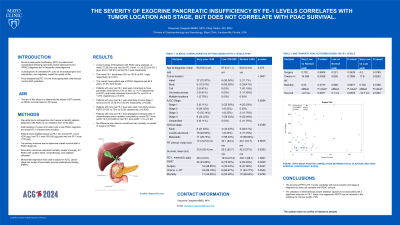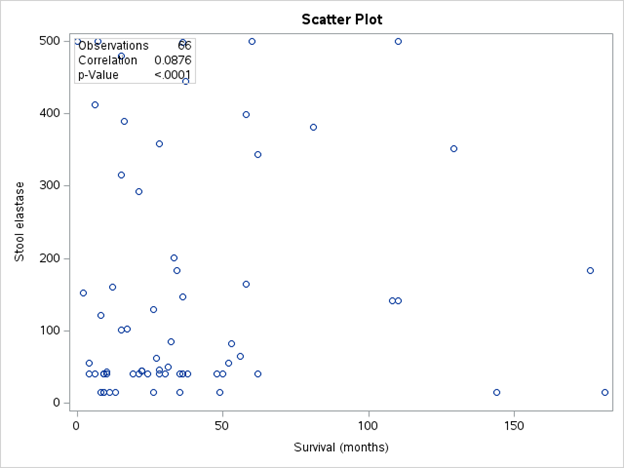Sunday Poster Session
Category: Biliary/Pancreas
P0054 - The Severity of Exocrine Pancreatic Insufficiency by FE-1 Levels Correlates With Tumor Location and Stage, But Does Not Correlate With PDAC Survival
Sunday, October 27, 2024
3:30 PM - 7:00 PM ET
Location: Exhibit Hall E

Has Audio

Osayande Osagiede, MBBS, MPH
Mayo Clinic
Jacksonville, FL
Presenting Author(s)
Award: Presidential Poster Award
Osayande Osagiede, MBBS, MPH, Philip Okafor, MD, MPH
Mayo Clinic, Jacksonville, FL
Introduction: Exocrine pancreatic insufficiency (EPI) is a well-known complication following pancreatic ductal adenocarcinoma (PDAC) diagnosis but is frequently underdiagnosed. Complications of untreated EPI, such as fat malabsorption and malnutrition, can negatively impact the quality of life. Fecal elastase test [FE-1] is the most appropriate initial test per current AGA guidelines. The aim of this study is to determine the impact of EPI severity on PDAC survival based on FE levels.
Methods: We performed a retrospective chart review to identify patients diagnosed with PDAC at our institution from 2016-2023. Adult patients (18 years and older) with a new PDAC diagnosis and actual FE-1 checked were included. Patients were stratified based on FE-1 into normal FE-1 level >200 μg/g, low FE-1 level 100-200 μg/g and very low FE-1 level < 100 μg/g. The primary outcome was to determine overall survival after a PDAC diagnosis. Secondary outcomes examined mortality, receipt of surgery for PDAC with curative intent, chemotherapy, and radiation utilization. Multivariate regression was used to adjust for AJCC cancer stage and receipt of PERT.
Results: A total number of 66 patients with PDAC were analyzed, of which 37 (56.0%) had very low FE-1 level, 12 (18.2%) low FE-1 level, and 17 (25.8%) normal FE-1 level respectively. The mean FE-1 levels were 38.4 vs 143.9 vs 404.1 μg/g respectively (p< 0.001). The overall mean patient age at PDAC diagnosis was 64.8 years, 51.5% were female. Patients with very low FE-1 level were more likely to have pancreatic head tumors (73% vs 50% vs 11.7% respectively, p< 0.001) and locally advanced tumors (48.7% vs 8.3% vs 11.8% respectively, p=0.019), but less likely to have stage 4 tumors (24.3% vs 58.3% vs 52.9% respectively, p=0.026). Patients with very low FE-1 level were also more likely receive PERT (91.9% vs 75% vs 52.9% respectively, p=0.004). Patients with very low FE-1 level displayed increased odds of chemotherapy and/or radiation compared to normal FE-1 level (aOR: 16.4, p=0.046) or low FE-1 level (aOR: 17.8, p=0.02). No difference was noted in overall survival, mortality, or receipt of surgery for PDAC.
Discussion: The severity of EPI by FE-1 levels correlates with tumor location and stage at diagnosis, but does not correlate with PDAC survival. The utilization of chemotherapy and/or radiation appears to be associated with a significant reduction in FE-1 levels, thus aggressive PERT may be required in this subgroup to improve quality of life.

Note: The table for this abstract can be viewed in the ePoster Gallery section of the ACG 2024 ePoster Site or in The American Journal of Gastroenterology's abstract supplement issue, both of which will be available starting October 27, 2024.
Disclosures:
Osayande Osagiede, MBBS, MPH, Philip Okafor, MD, MPH. P0054 - The Severity of Exocrine Pancreatic Insufficiency by FE-1 Levels Correlates With Tumor Location and Stage, But Does Not Correlate With PDAC Survival, ACG 2024 Annual Scientific Meeting Abstracts. Philadelphia, PA: American College of Gastroenterology.
Osayande Osagiede, MBBS, MPH, Philip Okafor, MD, MPH
Mayo Clinic, Jacksonville, FL
Introduction: Exocrine pancreatic insufficiency (EPI) is a well-known complication following pancreatic ductal adenocarcinoma (PDAC) diagnosis but is frequently underdiagnosed. Complications of untreated EPI, such as fat malabsorption and malnutrition, can negatively impact the quality of life. Fecal elastase test [FE-1] is the most appropriate initial test per current AGA guidelines. The aim of this study is to determine the impact of EPI severity on PDAC survival based on FE levels.
Methods: We performed a retrospective chart review to identify patients diagnosed with PDAC at our institution from 2016-2023. Adult patients (18 years and older) with a new PDAC diagnosis and actual FE-1 checked were included. Patients were stratified based on FE-1 into normal FE-1 level >200 μg/g, low FE-1 level 100-200 μg/g and very low FE-1 level < 100 μg/g. The primary outcome was to determine overall survival after a PDAC diagnosis. Secondary outcomes examined mortality, receipt of surgery for PDAC with curative intent, chemotherapy, and radiation utilization. Multivariate regression was used to adjust for AJCC cancer stage and receipt of PERT.
Results: A total number of 66 patients with PDAC were analyzed, of which 37 (56.0%) had very low FE-1 level, 12 (18.2%) low FE-1 level, and 17 (25.8%) normal FE-1 level respectively. The mean FE-1 levels were 38.4 vs 143.9 vs 404.1 μg/g respectively (p< 0.001). The overall mean patient age at PDAC diagnosis was 64.8 years, 51.5% were female. Patients with very low FE-1 level were more likely to have pancreatic head tumors (73% vs 50% vs 11.7% respectively, p< 0.001) and locally advanced tumors (48.7% vs 8.3% vs 11.8% respectively, p=0.019), but less likely to have stage 4 tumors (24.3% vs 58.3% vs 52.9% respectively, p=0.026). Patients with very low FE-1 level were also more likely receive PERT (91.9% vs 75% vs 52.9% respectively, p=0.004). Patients with very low FE-1 level displayed increased odds of chemotherapy and/or radiation compared to normal FE-1 level (aOR: 16.4, p=0.046) or low FE-1 level (aOR: 17.8, p=0.02). No difference was noted in overall survival, mortality, or receipt of surgery for PDAC.
Discussion: The severity of EPI by FE-1 levels correlates with tumor location and stage at diagnosis, but does not correlate with PDAC survival. The utilization of chemotherapy and/or radiation appears to be associated with a significant reduction in FE-1 levels, thus aggressive PERT may be required in this subgroup to improve quality of life.

Figure: Figure 1A: Fecal Elastase Level and PDAC survival (All patients). Very weak positive correlation between fecal elastase and PDAC survival (coefficient: 0.0876).
Note: The table for this abstract can be viewed in the ePoster Gallery section of the ACG 2024 ePoster Site or in The American Journal of Gastroenterology's abstract supplement issue, both of which will be available starting October 27, 2024.
Disclosures:
Osayande Osagiede indicated no relevant financial relationships.
Philip Okafor indicated no relevant financial relationships.
Osayande Osagiede, MBBS, MPH, Philip Okafor, MD, MPH. P0054 - The Severity of Exocrine Pancreatic Insufficiency by FE-1 Levels Correlates With Tumor Location and Stage, But Does Not Correlate With PDAC Survival, ACG 2024 Annual Scientific Meeting Abstracts. Philadelphia, PA: American College of Gastroenterology.


